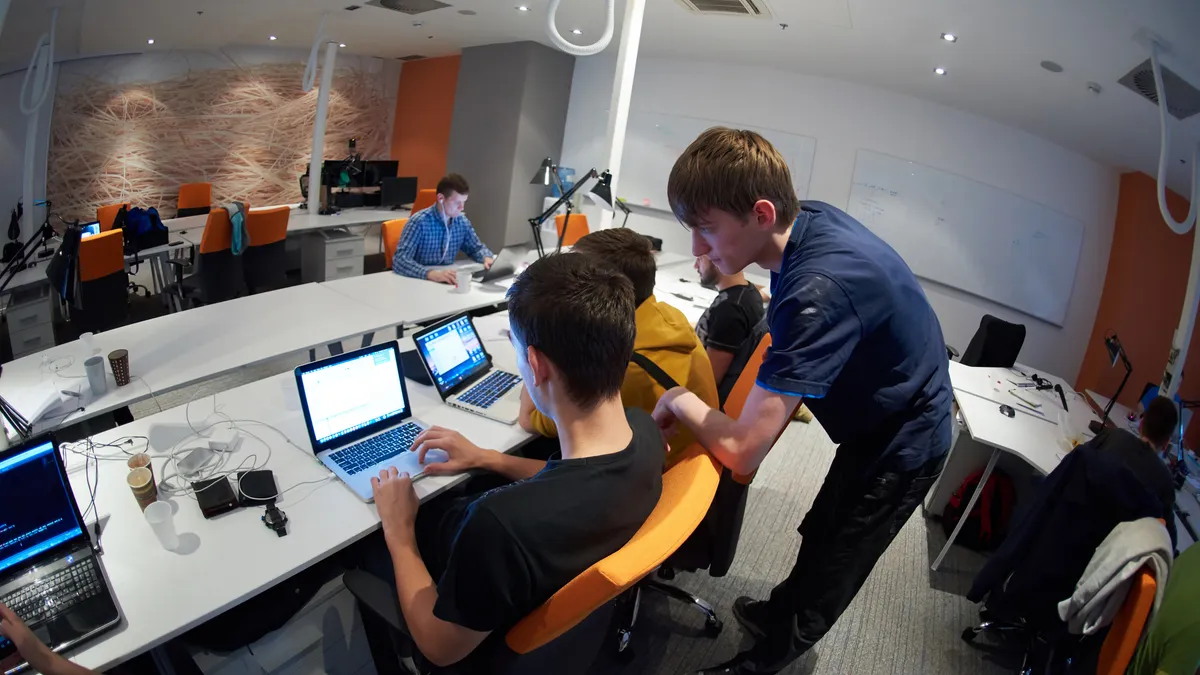Demand for learning is up and the spend that employers allocate to it is climbing — but as employers spend more money, they may also need to increase expectations for learning's success.
What outcomes do employers expect from learning programs? Whenever a company initiates training, that company must also ensure it has clear, definable results in mind, experts told HR Dive. Training to increase practical knowledge — how to utilize equipment, for example — should be task-oriented and measurable. Other training goals, like developing soft skills, may be more intangible, but success metrics can still be necessary.
Quantifying learning and finding success
The classic Kirkpatrick Model to evaluate training is widely used, Tom Griffiths, CEO and co-founder of Hone, explained to HR Dive. It covers four measurements:
- Reaction. Were workers actively engaged and participating in the program? Observation and reaction surveys can help with this metric.
- Actual learning. Did they come away from the session knowing more than they went in knowing? Baseline quizzes before and after give a snapshot of whether or not the session met objectives.
- Behavioral change. Are you seeing a change in the way people perform their work? If training isn't directly relatable and usable, this might be more difficult to quantify.
- Results. What is the final impact on the business overall following the training? Have errors decreased? Has productivity increased? Is customer satisfaction up? These measurements may take longer to quantify, but they're worthwhile metrics to obtain.
Ultimately, employers should keep an eye out for true measures of performance improvement, Anna Robinson, CEO of Ceresa, told HR Dive in an email. Sales growth, unit cost reductions and improved throughput are all examples of potential results. "If business performance improves, that means the right person is receiving the right content, and it is having an impact on their performance," she added.
But there are other ways to measure success, Ujjwal Gupta, co-founder and COO of BenchPrep, told HR Dive in an email. A learner getting that long-sought promotion or spreading knowledge in their department are key ways to witness a development program's success, Gupta said.
Changing minds and habits
What is the goal of training — changing minds or changing behaviors? Griffiths believes both are needed for a growth mindset, but one can lead to another.
"We can inspire change by giving learners the mental models, evidence and ways of thinking to start shifting their mindset, which can have a huge effect on behavior," he said. "For example, how differently do I behave if I believe I know everything and have nothing to learn from others, versus the mindset that I have something to learn from everyone?"
Employers should do more than just encourage learning, but should aspire to have a culture of learning, which enables employees to actively look for growth because learning is readily available and development is rewarded. For Griffiths, a successful learning culture is one that is open, aware and flexible. Ideally, there is a balance between dictating what the organization wants people to learn and giving the learners choice and control over what they learn to foster an employee-driven culture of learning, he noted.
Robinson said to look for engagement and buy-in. To gauge success of their mentoring program, for example, Ceresa looks at the number of women who are interested in continuing the relationship as well as the number who begin to mentor others. "This both extends and expands the learning culture," she said.
Has it made an impact?
Employees may be participating in learning exercises, but that doesn't necessarily translate to impact, experts warned. Knowledge can keep employees on track for what they need to be doing today, but it isn't enough on its own to ready them for new challenges or spark innovation. Seeing strong numbers on employee engagement surveys and significant changes in the way people work are key indicators, but the real goal is for employees to be hungry for more. Experts have noted that offering training outside workers' current areas of expertise and comfort zones can help push them further. Training that regards growth as the goal, whether or not it's of use at work today, can have the most impact on the employee and organization.
For Gupta, the numbers are important; evaluating retention and growth are leading indicators for those seemingly outside opportunities. "Seeing that you are not only keeping your employees happy, but that you are also expanding the business leads to a win-win situation by having a great learning culture that drives ROI," he said.












